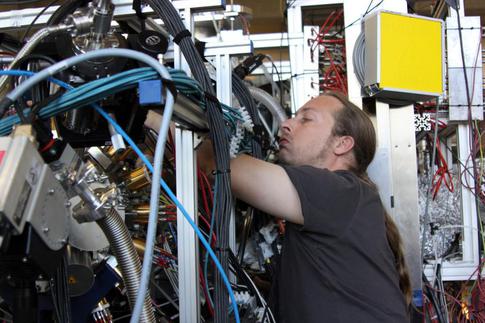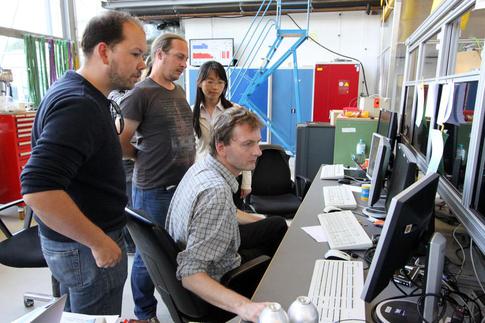XFEL: “Cookie Box” monitors ultrashort light pulses
“Cookie Box” monitors ultrashort light pulses
It’s no easy task to profile something going at light speed, let alone as an ultrashort flash lasting a few quadrillionths of a second. Diagnostic devices at the European XFEL will work to pin down the characteristics of the facility’s X-ray flashes as precisely as possible. Most light source diagnostic devices would record only one specific bit of information about the X-rays and totally consume them in the process. But European XFEL and DESY scientists are developing a device that can get a detailed look at flashes of X-ray light coming off of a free-electron laser at high repetition rates, all almost without disturbing the light.
The device is designed to produce measurements of the X-ray light’s spectrum and its polarization state. Polarization is the orientation of the electromagnetic field of light in the plane perpendicular to the propagation direction. Polarization can be linear (remaining constant at a particular direction, as in a laser pointer), circular (rotating in a clockwise or anticlockwise manner), or without polarization (as in a light bulb). Free-electron lasers can produce adjustable polarization in ultrashort pulses of light using various settings on their undulators, the magnetic devices that generate the X-rays from extremely fast electrons. Controlling the polarization that ends up in a scientist’s experiment is essential to performing certain experimental techniques—and this device provides information for such control at high speed and precision, and thanks to the gases chosen for use in the device, without altering the beam’s properties. It does this by simultaneously observing the direction and velocity of photoelectrons—electrons created by the interaction of the X-rays with a gas—using 16 identical time-of-flight electron detectors.

European XFEL scientist Jens Buck makes adjustments to the diagnostic device code-named 'Cookie Box' during a beamtime at FLASH. (Copyright European XFEL)
The apparatus—codenamed “Cookie Box” because of the resemblance of its central vacuum chamber to a tin of Danish butter cookies—was originally designed and developed by the working group of Jens Viefhaus, a DESY scientist at the X-ray radiation source PETRA III. European XFEL scientists are currently upgrading the device to cope with the unique beam properties of the facility.
The central chamber is surrounded by the ring of 16 electron detectors. Various gases, mainly noble gases such as helium, neon, or xenon, can be released into this chamber. The X-rays, which are destined for different scientific experiments in Schenefeld, pass through the chamber’s midpoint, with a few of them knocking photoelectrons out of the gas’s atomic shells. Some of those electrons fly into the ring of 16 electron detectors. The electron detectors register the flight time of the photoelectrons from their starting point in the gas to the detectors; their arrangement in a ring determines the photoelectrons’ direction. These two properties together allow for calculation of the energy and polarization of the X-ray beam.
Since the gas used in the apparatus is very dilute, and since higher-energy X-ray photons do not interact as much as lower-energy ones, most of the light passes through the “Cookie Box” without interacting. The X-ray beam can arrive at the user experiment basically undisturbed. This means the “Cookie Box” can be operated in parallel with any other experiment, with information about the beam properties linked directly to experiment data measured simultaneously. Related software is under development at European XFEL to translate the measured data into values for the polarization and energy of the X-rays in real time, coping with the high rate of light pulse delivery.
“The new device offers a major benefit for users as it will help them evaluate their data”, says Jens Buck, photon beam diagnostics scientist at European XFEL. “To get polarization and photon energy measurements done in one device without affecting the beam properties is unlike any other device out there.”
Following successful scientific and diagnostic measurements at FLASH at DESY and FERMI at Elettra Sincrotrone Trieste in Italy, the device was shipped to the Linac Coherent Light Source at SLAC in California. There, a team of European XFEL and DESY scientists will support commissioning of a new DELTA undulator, further investigate the response of the “Cookie Box” to an X-ray free-electron laser, and use the device for a beamtime led by SLAC’s Ryan Coffee and European XFEL scientist Markus Ilchen, who is at SLAC on a Paul Peter Ewald Fellowship from the Volkswagen Foundation.

From left: European XFEL scientists Patrick Geßler, Jens Buck, and Haiou Zhang examine readings from the 'Cookie Box' during an experiment at FLASH. The working group of DESY scientist Jens Viefhaus (seated) has led the development of the apparatus. (Copyright European XFEL)
These measurements will show to what extent the “Cookie Box” is ready to be used at European XFEL and what may have to be improved to deliver the best possible diagnostic unit for users.
“There is still much fine-tuning ahead of us”, Buck says. “But the upcoming experiments provide a great opportunity to demonstrate the outstanding capabilities of the 'Cookie Box'.”
